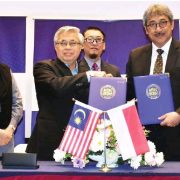Universitas Tanjungpura (Dr. Bintoro Siswo Nugroho) conducted a joint research among researchers from the University of Groningen (Dr. Jasper Knoester) and Institute of Technology Bandung (Dr. Alexander A. Iskandar). The research utilizes a scheme of International Cooperation and International Publication Research (first year) and Basic Research (second year) for two years (multi years) with the title of “Modeling the optical response of nanohybrid to explore their potential in nanophotonic application”.
In the first year of this collaborative research, the focus of the research was to study the Two-Photon Rabbi Oscillation phenomenon in nanohybrid systems consisting of semiconductor quantum dot (SQD) and metal nanoparticle (MNP). All analytical calculations and literature studies were carried out at the Department of Physics, Faculty of Mathematics and Natural Sciences, Universitas Tanjungpura while numerical calculations and analyzes were carried out at the Zernike Institute for Advanced Materials (ZIAM), University of Groningen. The output produced in the first year was: 1. Article entitled “Plasmon-assisted two-photon Rabbi oscillations in a semiconductor quantum dot – metal heterodimer nanoparticle“, published in Physical Review B (Q1 Scopus, IF = 3,736); 2. Article titled “Modification of Rabbinic Oscillation on Heterodimer Nanoparticles: Effect of Distance between Particles and Illumination Field Intensity“, published in the POSITRON Journal (accredited by SINTA 2).
In the second year, the collaborative research carried out a study of the effect of plasmon excitation on the phenomenon of nonlinear two-photon absorption (TPA). The system that was the object of research is still the same as in the first year, except for MNP which was replaced with metal nanoshell (MNS). Most of the analytical calculations are carried out in the Department of Physics, Faculty of Mathematics and Natural Sciences, Universitas Tanjungpura, except for the formulation of density matrix element that define quantitatively efficiency of the TPA. These parameters are calculated at ZIAM, University of Groningen. All numerical calculations that require high-performance computers (cluster) are performed at University of Groningen, as well as results analysis and article writing.



